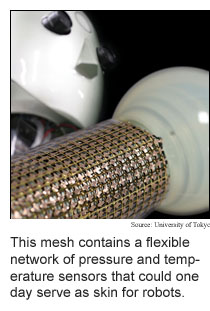
Week
of August 22, 2005
Give
it some skin
Consider a humanoid robot in your home. Would you trust it toput
away the dishes, hang a mirror, brush the dog or boil water on the stove?
One of the key differences between humanoid robots as they exist today
and humans is skin that is sensitive to pressure and temperature.
 Researchers from the University of Tokyo have developed a method
for making flexible
plastic mesh that contains pressure or temperature sensors at each
junction. The technique could lead to artificial skin with sensitivities
comparable to those of human skin. The technique also enables multiple
meshes containing different types of sensors to be laminated together.
A multiple-mesh skin could give robots not only sensitivity to pressure
and temperature, but also to light, humidity, strain and ultrasound.
Researchers from the University of Tokyo have developed a method
for making flexible
plastic mesh that contains pressure or temperature sensors at each
junction. The technique could lead to artificial skin with sensitivities
comparable to those of human skin. The technique also enables multiple
meshes containing different types of sensors to be laminated together.
A multiple-mesh skin could give robots not only sensitivity to pressure
and temperature, but also to light, humidity, strain and ultrasound.
(Conformable, Flexible, Wide-Area Networks of Pressure and Thermal
Sensors with Organic Transistor Active Matrixes, Proceedings of the
National Academy Of Sciences, August 23, 2005)
Fast nanotube fabrics
Carbon nanotubes are stronger than steel and have useful electrical
and optical properties, making them a prime candidate for all sorts of
strong, light, intelligent materials. The challenge to seeing the tiny
tubes through to their potential is making materials from them in bulk
in a way that preserves all the useful properties.
Researchers from the University of Texas at Dallas and the Commonwealth
Scientific and Industrial Research Organization (CSIRO) in Australia have
developed a commercially viable method
of manufacturing 5-centimeter-wide sheets of carbon nanotubes at a rate
of 7 meters per minute. Meter-long samples a thousand times thinner than
human hair are transparent, conduct electricity, absorb microwaves and
emit light. Potential applications include solid-state lighting, solar
cells, displays, and antennas built into car windows.
(Strong, Transparent, Multifunctional, Carbon Nanotube Sheets,
Science, August 19, 2005)
Domesticated algae
Throughout history, humans have used beasts of burden. As scientists
working in microscopic realms shift from exploring to exploiting, what's
old could become new again.
Scientists at Harvard University have attached
plastic beads to microorganisms and directed the movement of the tiny
organisms to cause them to transport the beads. The researchers burdened
one-celled algae that swim toward dim light and away from bright light
with beads as large as six thousandths of a millimeter. The method calls
for chemically attaching beads to the algae, using light to direct the
motion of the organisms, then detaching the beads at the destination using
ultraviolet light.
The tiny beasts could be used as power sources and transporters
in microfluidic devices.
(Microoxen: Microorganisms to Move Microscale Loads, Proceedings
of the National Academy Of Sciences, August 23, 2005)
Bend, but don't slow down
The possibilities of rollup displays and bendable electronic gadgets
have focused much attention on making circuits from plastic. Although
an impressive feat, today's prototypes are slower than the silicon devices
that have been widely used for decades.
As it turns out, however, flexibility doesn't necessarily require
the circuits themselves to be plastic, just the substrate they occupy.
Researchers at the University of Illinois at Urbana-Champaign have developed
a method
of printing microscopic gallium arsenide wires onto plastic surfaces shows
that circuits made from traditional high-speed metal and semiconductor
materials can be made to bend.
The high-speed flexible circuits could be used in communications
devices, space systems and flexible displays.
(Bendable GaAs Metal-Semiconductor Field-Effect Transistors Formed
with Printed GaAs Wire Arrays on Plastic Substrates, Applied Physics
Letters, August 22, 2005)
Bits and pieces:
A robotic
bat head emits and detects ultrasound, and even has movable ears;
a method of slowing
and speeding light traveling through optical fiber; and a prototype
fuel cell powered by coal.
RSS Feeds: News Blog Books New: TRN's Internet Services TRN's Jobs Center News: Research News Roundup Research Watch blog Features: View from the High Ground Q&A How It Works Buy an ad link |
|
| Advertisements: |
|
Ad links: Clear History
Buy an ad link
|
TRN
Newswire and Headline Feeds for Web sites
|